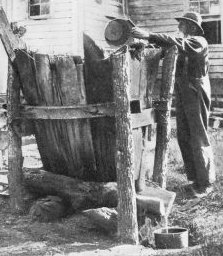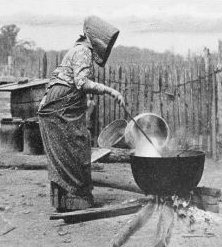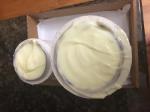Colonial Soap Making
Colonial Soap Making. Have you ever tried to imagine what it must have been like to try and create what we think of as life's simple necessities? Incredibly hard is what comes to mind!
Some of the links on this site are affiliate links. If you buy a product through them, I receive a small commission which helps me provide the free information you find on this site. Thank you for your support!
Unlike present day soap makers, the colonials had to first create their soap making ingredients. Thank goodness it's not like that now! The internet makes soap making soooo much easier.
For months, the colonials would collect hardwood ashes from their fires and place them in what was called a hopper.
The hopper was a device used to separate the lye from the wood ash. When enough ashes were saved, water was poured over them to leach out the lye. The lye solution would then have to be boiled until it reached a suitable strength.

Lye wasn't the only thing they had to make. The fats and oils had to be prepared as well.
Unfortunately they couldn't just drive down to the local corner store and pick some up.
Leftover cooking fat and uncooked animal fats would be collected and then cleaned.
This involved boiling the fat in an equal amount of water for hours until the fat was completely melted. Then the fat was left to cool and harden.
All the impurities would fall to the bottom of the pot with the water and the fat would float on top and solidify.
This process was done outside since the smell is said to be horrific and lingering.
Doesn't that sound like an unpleasant undertaking?! I'm pretty sure I wouldn't have made a very good colonial soap maker.

Once the colonists had their ingredients, they could begin the soap making process.
The lye solution was placed in a large kettle with the cleaned fat and boiled for hours until it became thick and frothy.
The success of colonial soap making was dependent on obtaining the correct balance between the lye and the fats.
The process did not involve precise measuring and it sometimes required several attempts before a suitable batch was made. I'm guessing the references you read about 'Grandma's soap leaving your skin red and raw' are a result of the process being so hit and miss!
Today, the art of making homemade soap is usually done for pleasure and the desire to make more natural, healthy choices. Though commercial soap is affordable and readily available, many people are finding it undesirable.
We are now aware that we are living in a world laden with chemicals and environmentally unsound products. As the website Natural Living For Women shows us, we can make natural choices that are beneficial to ourselves as well as the environment. Learning how to make soap is one of them.
There are a few different methods of making soap and each produces a product with its own unique qualities. Cold process soap making, the method mainly used on this site, hot process soap making, glycerin soap making, and liquid soap making are some of the most common.
Here is a quote about colonial soap making from Clifton Johnson's book Highways and Byways of the Mississippi Valley:
"I stopped at a farmhouse to talk with a sunbonneted white woman who was making soft soap in the yard. She had a fire with a great black kettle over it and said she was 'bilin' the lye. It has to bile slow all the morning,' she continued, 'till it's very strong. Then I put in the fat I've saved --- trimmin's of meat sich as we don't eat, pork rinds, and the cracklin's that we have left when we are trying out lard. After the fat is in I have to stir it every little while with a paddle and be careful not to have too big a fire, or it will bile over. So it simmers along till four or five o'clock and is done; and when it's stood to cool over night I dip it out into a flour barrel. If the soap is all right it's thick like jelly, and I'd much rather have it than the soap you buy. What I make in this kittle will run me a year."
Source: Johnson, Clifton. Highways and Byways of the Mississippi Valley (New York: Macmillan,1913).
Photographs on this page circa 1911 by Clifton Johnson


Facebook Comments